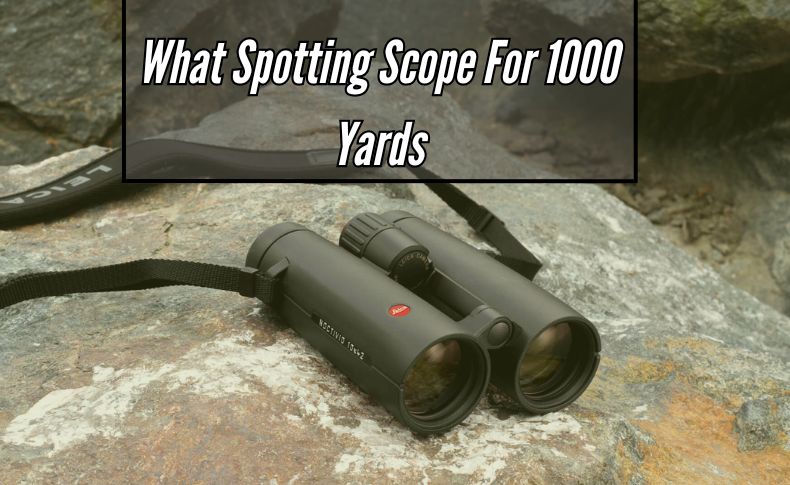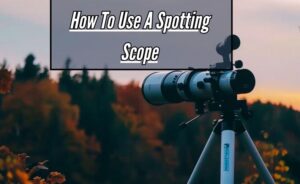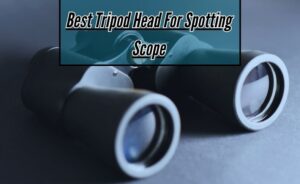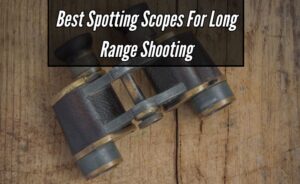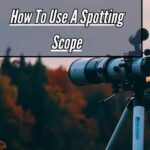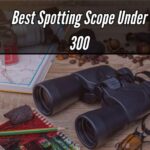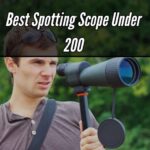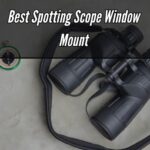Whether you’re hunting, birdwatching, or target shooting outdoors, selecting the best 1000 yard spotting scope can make a big difference. Choosing the ideal solution can be difficult given the abundance of options. However, the procedure can be made simpler if you know what essential traits to search for. When making a decision, factors including affordability, durability, quality of lens, and magnification power are important considerations. You may reduce the number of options you have and choose a spotting scope that is ideal for your requirements by taking these factors into account.
What Spotting Scope For 1000 yards? A spotting scope with excellent optics and magnification power—such as those with 20–60x or greater magnification and big objective lenses for increased light transmission—should be taken into consideration when searching for one at a distance of 1000 yards. For long-range observation and target shooting, brands like Vortex, Nikon, and Celestron provide great solutions that are renowned for their clarity and performance.
We’ll go over the key factors to take into account in this article when choosing a 1000-yard spotting scope, enabling you to make an informed decision for your upcoming outdoor experience.
In Focus: The Ultimate Guide to Spotting Scopes for 1000 Yards
Choosing the right spotting scope for viewing targets at 1000 yards requires careful consideration of several key factors. Here’s a comprehensive guide to help you make an informed decision.
Weatherproof Construction and Reliability
Durability goes hand in hand with reliability when it comes to spotting scopes. Opt for models with weatherproof construction, such as O-ring seals and nitrogen purging, to ensure consistent performance even in challenging outdoor conditions.
Ergonomic Design and Comfort
Comfort plays a crucial role, especially during extended viewing sessions. Look for spotting scopes with ergonomic designs, featuring comfortable eyecups, adjustable eyepieces, and easy-to-use focus knobs, to enhance your overall viewing experience at 1000 yards.
Versatility in Viewing Options
The versatility of a spotting scope can significantly impact its usability in various scenarios. Choose models that offer versatile viewing options, such as angled or straight eyepieces, to accommodate different preferences and viewing angles at long distances.
Enhancing Stability with Tripods
Stability is paramount when viewing distant targets, particularly at 1000 yards. Invest in a sturdy tripod compatible with your spotting scope to minimize vibrations and ensure steady, shake-free images, even in windy conditions.
Consideration of Field of View
A wide field of view is beneficial for tracking moving targets or scanning large areas. However, at 1000 yards, it’s crucial to prioritize optical quality over field of view.
Balance your need for a wide field of view with the requirement for detailed, magnified views of distant targets.
Portability and Weight
For long-range shooting or wildlife observation at 1000 yards, portability is key. Choose a spotting scope that strikes a balance between performance and weight.
Compact, lightweight designs are ideal for carrying on hikes or trips to the range without sacrificing optical quality.
Understanding the Importance of a Quality Spotting Scope for 1000 Yards

Long-range observation, particularly at distances of 1000 yards or more, demands precision and clarity. A quality spotting scope serves as the essential tool for this task, enabling enthusiasts, hunters, and marksmen to delve into the depths of distant landscapes with unparalleled clarity.
The Significance of High-Quality Optics
In the realm of long-distance observation, the quality of optics is paramount. A spotting scope equipped with top-tier optical components ensures sharpness, contrast, and color fidelity, allowing users to discern intricate details with ease. From wildlife spotting to target shooting, superior optics enhance the overall observation experience.
Engineering for Precision: Fine-Tuning Adjustability
Achieving precise viewing conditions requires meticulous adjustments. Quality spotting scopes offer a myriad of customizable settings, including focus, eyepiece diopter, and magnification, enabling users to fine-tune their observation setup for optimal clarity and comfort. This level of adjustability enhances usability across diverse viewing scenarios.
Craftsmanship and Endurance: Building for Longevity
In the pursuit of long-range observation, durability is non-negotiable. A well-built spotting scope withstands the rigors of outdoor exploration, featuring rugged construction and weather-resistant seals to ensure reliable performance in any environment.
By investing in a durable scope, users can confidently embark on their outdoor adventures without fear of equipment failure.
Performance Without Compromise: Enhancing User Experience
A quality spotting scope strikes the perfect balance between performance and user convenience. With features designed for ease of use and ergonomic comfort, such as intuitive controls and lightweight construction, users can enjoy extended observation sessions without fatigue or discomfort. This seamless integration of performance and usability enhances the overall observation experience.
Budget-Friendly Options for 1000-Yard Spotting Scopes: Balancing Performance and Price
When it comes to spotting scopes for long-range observation, finding the right balance between performance and price is essential.
Here, we delve into some budget-friendly options that offer excellent performance without breaking the bank.
Understanding Your Needs:
Before delving into the world of spotting scopes, it’s essential to assess your specific requirements. Consider factors such as your intended use, budget constraints, and the environments in which you’ll be operating.
This initial step lays the groundwork for finding a spotting scope that strikes the perfect balance between performance and price, tailored to your individual needs and preferences.
Optical Quality and Performance:
While budget-friendly, spotting scopes can still deliver impressive optical performance if you know where to look.
Look for scopes with fully multi-coated lenses and quality prisms, as these features significantly enhance light transmission and minimize glare without inflating the price tag. By prioritizing optical quality, you can ensure crisp, clear views of distant targets without compromising on affordability.
Value-Added Features:
When shopping for a budget-friendly spotting scope, keep an eye out for value-added features that enhance usability and versatility. These may include integrated tripod mounts, smartphone adapters for digiscoping, and angled eyepieces for comfortable viewing at different angles.
Prioritize features that align with your specific needs and activities, maximizing the value of your investment without exceeding your budget.
User-Friendly Design:
Ease of use is paramount when selecting a spotting scope, especially for beginners or casual users. Look for scopes with intuitive controls, smooth focusing mechanisms, and ergonomic design features that enhance usability and reduce user fatigue during extended observation sessions.
A user-friendly design ensures that you can focus on enjoying the experience rather than grappling with complicated controls or uncomfortable handling.
Long-Term Durability:
While affordability is a primary concern, durability should not be overlooked when choosing a budget-friendly spotting scope. Opt for scopes constructed from sturdy materials such as aluminum or fiberglass-reinforced plastic, ensuring long-term reliability and performance.
Additionally, prioritize models with weatherproofing features like O-ring seals and nitrogen purging, which protect against moisture, dust, and other environmental factors that can compromise the scope’s integrity over time.
Final Thoughts:
Finding a budget-friendly spotting scope for 1000-yard observation is entirely feasible with careful consideration and research. By understanding your specific needs, prioritizing optical quality and performance, and seeking out value-added features, you can strike the perfect balance between performance and price.
Whether you’re a seasoned outdoor enthusiast or a beginner looking to explore the world of long-range observation, there are plenty of options available that offer excellent performance without breaking the bank.
Expert Tips for Maximizing Clarity and Accuracy When Using a Spotting Scope at 1000 Yards
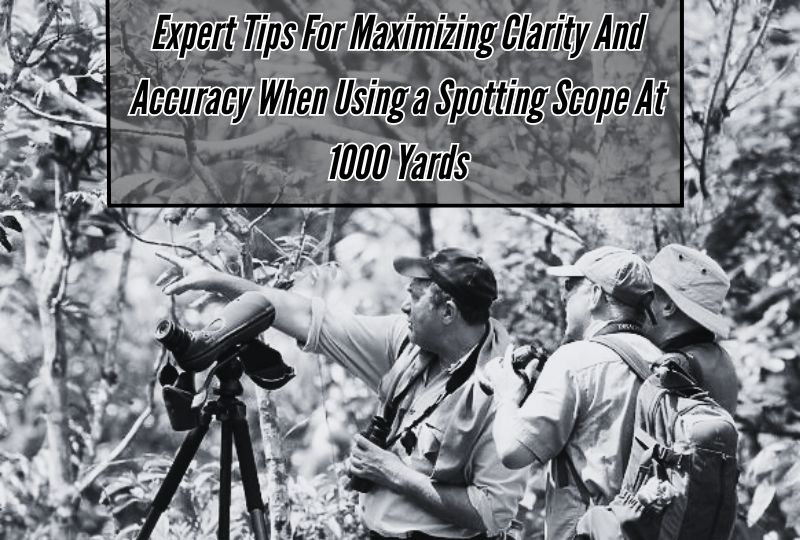
Spotting scopes are invaluable tools for precision shooting and observation, especially when you’re dealing with targets at long distances like 1000 yards.
However, achieving optimal clarity and accuracy requires more than just pointing and looking. Here are some expert tips to help you get the most out of your spotting scope:
Understanding Optics:
To maximize clarity, it’s essential to understand the basics of optics. Familiariz e yourself with terms like magnification, objective lens diameter, and exit pupil.
Higher magnification isn’t always better, as it can lead to decreased image quality, especially in low-light conditions.
Choosing the Right Spotting Scope:
Invest in a spotting scope that suits your needs and budget. Look for features like ED glass, which reduces chromatic aberration, and fully multi-coated lenses for maximum light transmission.
Consider factors such as weight, durability, and weather resistance, especially if you’ll be using the scope in harsh conditions.
Stabilizing Your Setup:
Stability is crucial when viewing distant targets. Use a sturdy tripod with a fluid head for smooth adjustments and minimal vibration.
Avoid extending the tripod legs fully, as this can compromise stability. Additionally, consider using a counterbalanced weight to offset the weight of the scope and reduce tipping.
Adjusting Focus and Diopter:
Take the time to properly focus your spotting scope for sharp images. Start by adjusting the main focus wheel to bring the target into view, then fine-tune the focus using the diopter adjustment ring to compensate for any differences in your eyesight. Regularly check and readjust focus as lighting conditions change.
Managing Light and Glare:
Glare can degrade image quality, especially when viewing targets in bright sunlight. Position yourself to minimize glare by using sunshades or shading your eyes with your hand.
Additionally, consider using a polarizing filter to reduce reflections and enhance contrast, especially when viewing water or shiny surfaces.
Using Spotting Scope Accessories:
Maximize the versatility of your spotting scope by using accessories like digiscoping adapters for capturing images and videos with your smartphone or camera.
Lens hoods can help reduce stray light and protect the objective lens from damage. Experiment with different accessories to find what works best for your setup.
Practicing Proper Technique:
Lastly, practice proper spotting scope technique to hone your skills and improve accuracy. Maintain a stable shooting position, relax your breathing, and use slow, deliberate movements when adjusting the scope. Take the time to familiarize yourself with the scope’s controls and features to work efficiently in the field.
Key Features to Consider When Choosing a Spotting Scope for 1000 Yards
Looking for a spotting scope to observe distant targets at 1000 yards? Selecting the right one involves considering key features.
Optics quality, magnification, lens size, portability, and weather resistance are crucial. Understanding these factors helps ensure a satisfying viewing experience in various outdoor settings. Let’s explore what to look for.
Understanding the Basics:
Spotting scopes serve as essential tools for outdoor enthusiasts, offering magnification capabilities similar to telescopes but with added portability and versatility.
When selecting the ideal spotting telescope for long-distance viewing, particularly at distances of 1000 yards, several key features should be carefully considered to ensure optimal performance and satisfaction.
Consider Your Intended Use:
Before delving into the technical aspects, it’s crucial to assess your specific needs and intended applications for the spotting scope. Whether you’re an avid birdwatcher, target shooter, or nature enthusiast, understanding how you’ll primarily use the scope will guide your decision-making process.
This consideration will help narrow down features and functionalities that align with your requirements, ensuring a well-suited investment.
Optics Quality: Clarity and Resolution Matter:
One of the most critical factors in selecting a spotting scope is the quality of its optics. Clarity and resolution play pivotal roles, particularly when observing targets at extended distances. Look for spotting scopes equipped with high-quality lenses and prisms that minimize distortion and deliver sharp, detailed images.
Additionally, consider coatings such as fully multi-coated or ED (extra-low dispersion) glass, which enhance light transmission and color fidelity, resulting in superior viewing experiences, even in challenging lighting conditions.
Size and Portability:
While optical performance is paramount, the size and portability of the spotting scope also merit attention, especially if you plan to transport it frequently or use it in various outdoor settings. Opt for a compact and lightweight design without compromising on optical quality.
A manageable size ensures ease of handling and convenience during outdoor adventures, whether hiking through rugged terrain or setting up at shooting ranges.
Understanding Magnification and Objective Lens Size:
Balancing magnification power and objective lens size is crucial for achieving optimal performance at 1000 yards. Higher magnification allows for detailed observation of distant subjects, but it can also result in reduced field of view and image stability. Consider spotting scopes with variable amplification settings to adapt to different viewing scenarios.
Additionally, larger objective lenses gather more light, enhancing brightness and image clarity, especially in low-light conditions. However, keep in mind that larger objective lenses may contribute to increased weight and bulkiness, so find a suitable compromise based on your preferences and intended use.
Weather Resistance: Ready for Any Conditions:
Outdoor adventures often expose spotting scopes to various weather conditions, including rain, fog, and extreme temperatures. Therefore, choosing a scope with robust weather-resistant construction is essential for long-term durability and performance reliability.
Look for features such as nitrogen purging or O-ring seals that prevent moisture ingress and protect against fogging, ensuring clear visibility regardless of the weather conditions. Additionally, opt for durable and rugged materials that withstand rough handling and outdoor elements, guaranteeing a reliable companion for your outdoor pursuits.
The Distance Dilemma: Selecting the Ideal Spotting Scope for 1000 Yards and Beyond
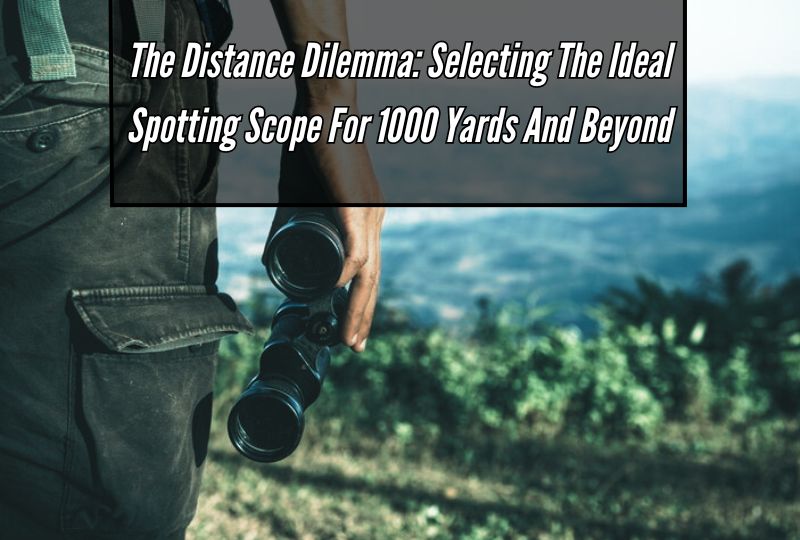
Unveiling the Long-Range Precision: Introduction to Spotting Scopes
Spotting scopes serve as indispensable tools for precision shooting at extended distances, providing shooters with unparalleled clarity and magnification capabilities. Delving into the world of spotting scopes reveals a myriad of options tailored specifically for sharpshooters aiming to hit targets 1000 yards away.
Engineering Excellence: Crafting Optimal Performance
Behind every top-tier spotting scope lies meticulous engineering focused on delivering optimal performance. Manufacturers leverage advanced technologies and superior materials to create scopes that offer exceptional optical quality, durability, and precision.
Understanding the engineering nuances allows shooters to select spotting scopes that align with their specific needs and preferences.
Innovative Design: Enhancing User Experience
Innovation drives progress in the realm of spotting scopes, leading to the development of features and designs aimed at enhancing the user experience.
From ergonomic adjustments to intuitive controls, spotting scopes are crafted with the shooter in mind, ensuring comfort, convenience, and ease of use during extended shooting sessions. Exploring the innovative design elements empowers shooters to make informed choices based on their unique requirements.
Beyond the Basics: Exploring Advanced Features
While fundamental features like magnification and lens diameter play crucial roles in spotting scope performance, it’s the advanced features that elevate certain models to the top of the list.
Features such as image stabilization, reticle options, and smartphone compatibility offer additional functionalities that cater to the diverse needs of sharpshooters. Evaluating the presence and effectiveness of these advanced features allows shooters to unlock the full potential of their spotting scopes.
The Art of Balance: Finding the Perfect Combination
A careful balance must be struck between a number of parameters, including as optical quality, amplification, durability, and cost, when choosing the best spotting scope for 1000-yard shooting.
A perfect shooting experience is ensured by finding the ideal configuration of features and specs suited to each individual’s tastes. Sharpshooters can purchase spotting scopes with confidence if they have mastered the technique of balancing.
A Lens into the Future: Emerging Technologies and Trends
Scope makers are always pushing the envelope of innovation as spotting scopes continue to advance along with technology. Novel technologies like lightweight materials, sophisticated image processing algorithms, and augmented reality overlays have the potential to completely change how shooters interact with their targets.
We may learn a lot about the future of long-range shooting and spotting scopes by keeping a watch on these new developments in technology.
Conclusion
In conclusion, improving your outdoor experiences requires selecting the best 1000-yard spotting scope. To guarantee optimum performance, take durability, lens quality, and magnification into account. A good spotting scope is essential whether you’re hunting, birdwatching, or just taking in the scenery.
To determine which solution best meets your needs, take your time investigating and trying out many possibilities. With the correct spotting telescope by your side, you can fully appreciate the beauty of the outdoors and take in sharp, clear views of faraway targets.
Frequently Asked Questions(What Spotting Scope For 1000 Yards)
What magnification is ideal for 1000-yard shooting with a spotting scope?
The best magnification range for 1000-yard shooting with a High-Power Telescope is usually 20x to 60x. This preserves image quality while enabling you to see targets in the distance with clarity. Higher magnifications aid in examining details, while lower amplification magnifications offer a wider field of vision to aid in target acquisition.
Finding a balance depending on your unique requirements and the surrounding environment is essential. When selecting your magnification levels, keep in mind that variables like mirage and air turbulence might impair visual sharpness. This will help you get the best results.
Why is objective lens size important for 1000-yard spotting scopes?
For 1000-yard spotting scopes, the size of the objective lens is critical since it dictates how much light the scope can collect. More light may reach the scope with a bigger objective lens, which improves image brightness and clarity, particularly in low light. For long-range observation, such as identifying objects at 1000 yards, this is essential.
It is simpler to detect far-off targets or wildlife with a scope that has a larger objective lens because it produces a crisper, more detailed image. Therefore, for best results in different lighting conditions, take into account a bigger objective lens size while selecting a spotting scope for long-range application.
Is image quality affected by the type of prism used in spotting scopes for long-range shooting?
The clarity of images obtained during long shooting range might be affected by the prism type used in spotting scopes. A minor reduction in visual brightness may occur when using porro prisms, despite their low cost. But, roof prisms, which are more costly and compact, provide superior light transmission, improving the sharpness of the image.
The image quality is further enhanced with prisms that use ED (extra-low dispersion) glass, which reduces color aberrations. This means that selecting a spotting scope with premium roof prisms and ED glass can improve image sharpness and color accuracy—two important factors for achieving the best results when shooting at a distance.
How does eye relief impact comfort during extended use for long-range spotting?
When long-range spotting, eye relief is essential to comfort. The distance measured between your eye and the spotting scope’s eyepiece is what it really means. You may keep a comfortable viewing distance with a longer eye relief, which lessens eye strain when using the device for lengthy periods of time. In particular, people who use glasses should pay attention to this.
You won’t have to squeeze your eyes too tight to see the complete field of view if there is sufficient eye relief. For a more comfortable and enjoyable viewing experience, especially during extended observation periods, select a spotting scope model that offers adequate eye relief.
What is the significance of lens coatings in 1000-yard spotting scopes?
In 1000-yard spotting scopes, lens coatings are essential for improving performance and image quality. These coatings have several functions, including lowering reflections, enhancing light transmission, and decreasing glare. By doing this, they enhance brightness, contrast, and clarity of images—especially in difficult lighting situations.
Lens coatings also guarantee long-term durability by shielding the glass from scuffs and other harm. To put it another way, lens coatings ensure that you can see far-off things clearly and in detail, which increases the usefulness of your Spotting telescope for long-range target shooting, hunting, and bird viewing.
Can a straight or angled spotting scope be more suitable for 1000-yard observations?
A straight spotting scope is usually better suited for observations at 1000 yards. Because it provides a straight line of sight, tracking and locating far-off objects is made simpler. The simple design offers an easy-to-use viewing experience, making it particularly suitable for novices.
However, because they enable comfortable observation by several users of varying heights, angled Spotting Binoculars are more adaptable and preferable in group settings. On the other hand, because to its simplicity and convenience of use, a straight Telescope is frequently chosen for individual observations at 1000 yards.

